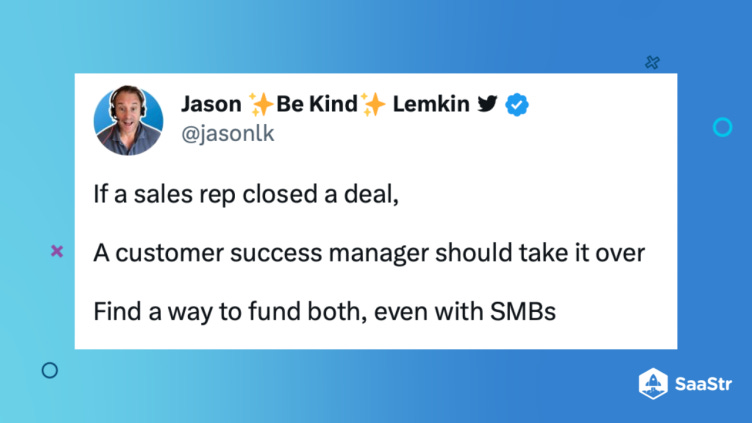Do SMBs Need Customer Success? 100% For Sure If You Also Have Sales Involved
"Find a way to fund it — especially if you want NRR of 100%+"
An open question around smaller customers is how do you staff up Customer Success for them — if at all. Many founders wrestle with the question of if they can really afford customer success professionals for their smaller customers. And as startups scale, many try to automate away support and success for the smaller accounts. But let’s challenge that.
Generally speaking, most self-service products supply very limited dedicated Customer Success. And all enterprise and mid-market products do. The grey area is often with SMBs. Can you afford to do customer success there? Often, the coverage is quite limited.
I’d suggest a few basic thoughts and rules:
If you have sales involved, then you need customer success, too. If your SMB product requires or has a salesperson involved in closing, that’s a clear sign you also want a human being involved in making sure that customer is a success post-sale, too. Any product that has sales involved, by definition, doesn’t sell itself, and doesn’t 100% lend itself to self-service and importantly, self-deployment. If a customer needs a salesperson to get going, they’re almost certainly going to need, or at least benefit from, help getting up and going with the product as well. And with questions on improving things over time. A wiki, some self-service Q+A, and a bunch of bots are not enough. Not to ensure success of a product that takes work to deploy, i.e., a product that needs salespeople.
Just assign a certain amount of ARR per each SMB customer success manager. There are only so many customers per day a CSM can proactively reach out to. But what you can do is just assign a certain number SMB and smaller customers that sum up to the amount of ACV you want to cover per CSM. For example, let’s say you are scaling and want each CSM to cover $1m in revenues. If your ACV is $2.5k, yes, that’s going to be 400 accounts to that CSM. That’s too many to schedule QBRs with. But it’s not too many to reach out to proactively with regular cadences. A bunch may not want to talk. More may just have a question by email. You’d be surprised over 52 weeks how many of these 400 accounts you can touch. All of them, multiple times, really.
Have a clear line between support and CS. Support has to handle a lot of routine SMB issues anyways. Create a clear line on who owns what, and your CSMs will be able to handle a high number of accounts.
Set clear KPIs on NRR and retention. Set a retention goal for your SMB customer success manager(s) and let them figure it out. This almost always works. They’ll adjust their time and strategy to drive churn down and retention up.
Find a way to fund it — especially if you want NRR of 100%+. You can’t save money not having customer success, especially if you want to drive NRR above 100%. Squarespace is all self-service, and it has 85% NRR (more here). But many SMB leaders do far better, well above 100% — see Bill.com’s 120% (more here), Smartsheet’s 110% NRR from SMBs (more here), Zendesk’s 100% NRR from SMBs (more here), and much more. Invest here to drive NRR up. A deeper dive on top-tier NRR for SMBs here.
We did a deep dive with Andrew Bialacki, the CEO of $9.5B ecommerce marketing leader Klaviyo here on this point.
The vast majority of their customers are SMBs, often starting around $200 a month. And they almost all have both customer success and post-sales support. Humans involved in making the whole customer journey great:
They have AEs setup the account before folks become customers
$2.5k ACV up, they pair AEs + CSMs, because their ARR retention is so good (brands grow)
Find a way to fund it. Your brand benefits alone will make it worth it. Even if, on paper, the SMB CSMs barely cover their costs.



